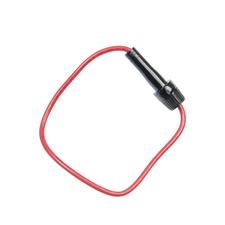Tech Talk
Forum home - Go back to Tech talk
|
Check your equipment!
|
|
|
Return to top of page · Post #: 16 · Written at 11:35:30 AM on 4 January 2017.
|
|
|
|
Location: Oradell, US
Member since 2 April 2010 Member #: 643 Postcount: 830 |
I've used fuseholders that have wire leads on the primary mains side under the chassis. 
|
|
|
Return to top of page · Post #: 17 · Written at 6:21:41 PM on 4 January 2017.
|
|
|
|
Location: Adelaide, SA
Member since 27 February 2010 Member #: 630 Postcount: 392 |
|
Hi ‾‾‾‾‾‾‾‾‾‾‾‾‾‾‾‾‾‾‾‾‾‾‾‾‾‾‾‾‾‾‾‾‾‾‾‾‾‾‾‾‾‾‾‾‾‾‾‾‾‾‾‾‾‾‾‾‾‾‾‾‾‾‾‾‾‾‾‾ Valve radios, They just don't make them like they used to |
|
|
Return to top of page · Post #: 18 · Written at 7:24:49 PM on 4 January 2017.
|
|
|
|
Location: Belrose, NSW
Member since 31 December 2015 Member #: 1844 Postcount: 2372 |
|
Yes, fuses are a problem. It usually takes a sudden catastrophic fault to blow a fuse that's large enough so as to not to fail in service when there's actually no fault. There are many possible faults that can cause a "slow cook" and even a fire without blowing the fuse. Back when I did warranty service on new B&W TVs, an O/C fuse with no other apparent fault was one of the most common reasons for service calls. |
|
|
Return to top of page · Post #: 19 · Written at 8:35:50 PM on 4 January 2017.
|
|
|
|
Location: Sydney, NSW
Member since 28 January 2011 Member #: 823 Postcount: 6687 |
|
Retrofitting thermal fuses is a damn good idea. It would make a good article for the Vintage Radio section of Silicon Chip. |
|
|
Return to top of page · Post #: 20 · Written at 9:21:48 PM on 4 January 2017.
|
|
|
|
Location: Adelaide, SA
Member since 27 February 2010 Member #: 630 Postcount: 392 |
|
I would go for the thermal fuse just need a way to attach it to the transformer. ‾‾‾‾‾‾‾‾‾‾‾‾‾‾‾‾‾‾‾‾‾‾‾‾‾‾‾‾‾‾‾‾‾‾‾‾‾‾‾‾‾‾‾‾‾‾‾‾‾‾‾‾‾‾‾‾‾‾‾‾‾‾‾‾‾‾‾‾ Valve radios, They just don't make them like they used to |
|
|
Return to top of page · Post #: 21 · Written at 11:06:43 PM on 4 January 2017.
|
|
|
|
Location: Sydney, NSW
Member since 28 January 2011 Member #: 823 Postcount: 6687 |
|
Yes, be wary of Jaycar inline holders. |
|
|
Return to top of page · Post #: 22 · Written at 8:38:37 AM on 5 January 2017.
|
|
|
|
Location: NSW
Member since 10 June 2010 Member #: 681 Postcount: 1256 |
|
"Getting back to the Fuse, the big problem I have is where do you put them? " |
|
|
Return to top of page · Post #: 23 · Written at 10:20:52 AM on 5 January 2017.
|
|
|
|
Location: Belrose, NSW
Member since 31 December 2015 Member #: 1844 Postcount: 2372 |
|
Put one of these inside two layers of fibreglass or silicone rubber sleeving, wire in series with mains and glue to the transformer: |
|
|
Return to top of page · Post #: 24 · Written at 7:14:57 PM on 5 January 2017.
|
|
|
|
Location: Adelaide, SA
Member since 27 February 2010 Member #: 630 Postcount: 392 |
|
To be honest I would use this type if I decide to go further. They are 240V rated. ‾‾‾‾‾‾‾‾‾‾‾‾‾‾‾‾‾‾‾‾‾‾‾‾‾‾‾‾‾‾‾‾‾‾‾‾‾‾‾‾‾‾‾‾‾‾‾‾‾‾‾‾‾‾‾‾‾‾‾‾‾‾‾‾‾‾‾‾ Valve radios, They just don't make them like they used to |
|
|
Return to top of page · Post #: 25 · Written at 7:52:28 PM on 5 January 2017.
|
|
|
|
Location: Sydney, NSW
Member since 28 January 2011 Member #: 823 Postcount: 6687 |
|
They are 240V rated |
|
|
You need to be a member to post comments on this forum.
|
|

Sign In

Vintage Radio and Television is proudly brought to you by an era where things were built with pride and made to last.
DISCLAIMER: Valve radios and televisions contain voltages that can deliver lethal shocks. You should not attempt to work on a valve radio or other electrical appliances unless you know exactly what you are doing and have gained some experience with electronics and working around high voltages. The owner, administrators and staff of Vintage Radio & Television will accept no liability for any damage, injury or loss of life that comes as a result of your use or mis-use of information on this website. Please read our Safety Warning before using this website.
WARNING: Under no circumstances should you ever apply power to a vintage radio, television or other electrical appliance you have acquired without first having it checked and serviced by an experienced person. Also, at no time should any appliance be connected to an electricity supply if the power cord is damaged. If in doubt, do not apply power.
Shintara - Keepin' It Real · VileSilencer - Maintain The Rage
